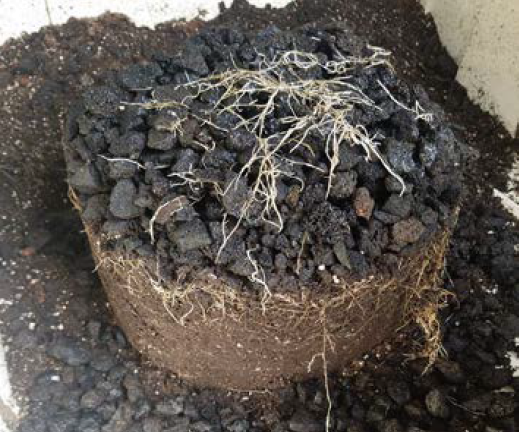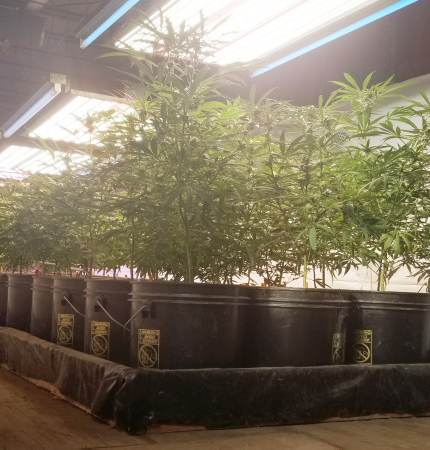Darryl Cotton of Inda-Gro and 151 Farmers continues in the second part of his series on closed-loop aquaponic systems. Now we start setting up our grow media and grow buckets for fish exchange.
If you would like to read part one, click here.

The following is an article produced by a contributing author. Growers Network does not endorse nor evaluate the claims of our contributors, nor do they influence our editorial process. We thank our contributors for their time and effort so we can continue our exclusive Growers Spotlight service.
Before we go into great technical detail as to how a closed-loop aquaponics system works, we should cover what a “151 Farm” is, and why it matters.
What is a 151 Farm?
We picked the name 151 as a way to reference the two main elements of our farms which combine medical cannabis and food. 151 may reference our minimum crop production values of 1 pound of cannabis per 5 pounds of food for 1 community.
5 Pounds of Food for
1 Community
151 is also an easy way to remember the ideal target ratios relative to the number of fish and their size to the amount of water in the system relative to the plant media bed area.
5 Gallons of Water to
1 Sq-Ft of Media Bed
If you would like to learn more about 151 farming, check out our information on our website.
What’s Going on in the Bottoms of Our Buckets?

Here at 151 Farmers, we “feed” our plants using a flood-and-drain setup, otherwise known as “ebb-and-flow.” Because we primarily bottom-feed our plants, lava rock at the bottom of buckets has worked very well for us.
When we flood our flood trays, we don’t let the water run up to more than four inches. This means that all the water that the plant is getting is coming up from the roots. The tap roots seek out the fish water and wrap around and into the lava rock. Additionally, the lava rock at the bottom also allows water to seep into the buckets without any plugging or resistance that you might experience with an all-soil design.

Since the lava rock is porous, it allows beneficial bacteria to live within it. This bacteria consumes nitrites in the fish waste, converting them into nitrates. The expelled nitrates are the macronutrients necessary for happy, healthy and organically grown plants.
Just in case you weren’t following the mutualistic symbiosis, or as a quick reminder, here’s a quick breakdown of aquaponics:
- The plants need the fish and the bacteria. Fish fecal matter is critical to meeting the plant’s nutrient needs, and bacteria break the fish matter into usable nutrients.
- The fish need the plants and bacteria. Both the plants and bacteria keep nitrite levels low and non-toxic, and also serve as potential food sources.
- The bacteria need the fish and the plants for raw sources of food and support.
Let’s Talk Media.
When it comes to what we put on top of the lava rock, we’ve experimented with many different mediums over the years. For some time, we were most comfortable with a coco-coir/soil mix that allowed us to combine the benefits of a soil garden with that of a hydroponic system.
What I’ve always liked about coco coir is that it was loosely packed into our buckets and would expand when it got wet. The downside with Coir was that it didn’t hold moisture very well, so amended soil was added to assist in that.
The coco coir was also sustainable and reusable. This was an important consideration since all materials must perform on an economic and environmental level for these 151 Farms to realize their full potential.
However, over time, most media will get compacted and aeration levels will drop off deep within the media. Because of this, we’ve always been on the lookout for a sustainable, non-compressible media that allows increased aeration throughout the entire root zone.
I used spun-rock media in the past, and was very familiar with the benefits of Grodan and rockwool products. When it comes to maintaining water and nutrients in the root zone, spun-rock type media is outstanding. Unfortunately this media comes in a highly compressed cube or slab which does not lend itself to the full plant root aeration I was looking for in a bottom fed watering system such as ours. But I wasn’t giving up on it.
Let’s Talk Recycling Spun Rock Media.
There were two problems with some of the more common rockwools:
The first thing we encountered was that the binding agent used in the compression process for blocks and cubes is proprietary. Without that information I’m going to risk putting their products into a system where our fish are potentially going to be exposed to chemical agents being released in the water.

The next thing we discovered about them was that they were not truly sustainable. Unless the used media is returned to the manufacturer, where it will then be torn down and reconstituted for resale, it is not being reused at all. That means it ends up in our landfills leaching nutrients into our aquifers. As a media I like spun-rock but these issues are unacceptable.
Growpito Saved Spun Rock Media
Just when I going to give up on spun-rock as a media for our buckets I got a phone call from one of my clients in Michigan, who also grows aquaponically, and he told me about a spun-rock media that he was using with success. When I told him the reasons that I had pretty much given up on spun-rock, he told me check out another company based out of Kansas City, MO. That company is Growpito.
Prior to that, I had never heard of Growpito. What I was able to learn online got me interested. The first thing you’ll notice is that it’s fluffy; it’s not compressed in any way. It’s chemically inert and completely safe for fish. Since it’s in a raw, unprocessed form it does not contain any binders. It’s also a perpetual product. You buy it once and use it over and over again without replacing it. After every harvest you will simply pH the product before using it again. Growpito does not build up salts and as it ages it actually gets better with each harvest.
Having now used their products as a replacement to our Coir/Soil mix, I am happy to report that when using Growpito less is definitely more. Here’s what I can also report:
- When you first get Growpito you will need to charge it. This means you get it completely saturated in a tub of 5.5 pH water and really work the water into the media. Once saturated it’s ready to be put into the buckets.
- Growpito has black sponge pellets in the mix which is where the beneficial bacteria lives once it has been added at initial planting.
- Growpito holds water exceptionally well. We went from summer watering of our outdoor plants once per day to once every 3-4 days. Our indoor cannabis plants get a top water of trace minerals from the dosing tank once every 5-6 days. Nutrient levels have been reduced from what was a 1.5 EC to a 0.5 EC.
- The plants really love this media! The fluffy consistency improved the aeration levels in the buckets. Both the plants and I love it!
Stay tuned for the final part of our introduction to closed-loop aquaponics, where we cover other equipment and considerations.
10 Best Gift Ideas for Cannabis Connoisseurs and Growing Aficionados (2022)
December 7, 2022Developing and Optimizing a Cannabis Cultivation System
December 14, 2021Dealing with Insomnia: How Can CBD Help?
December 10, 2020Your Guide to Sleep and CBD
December 7, 2020
Do you want to receive the next Grower's Spotlight as soon as it's available? Sign up below!
Resources:
Want to get in touch with Inda-Gro or Darryl Cotton? They can be reached via the following methods:
- Website: http://151farmers.org/
- Email: orders@inda-gro.com
- Phone: (877) 452-2244
